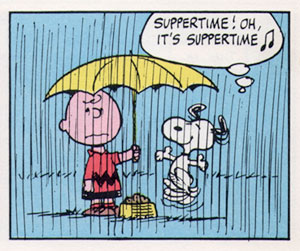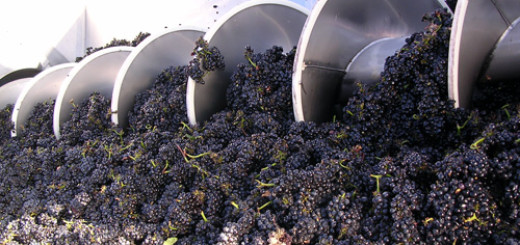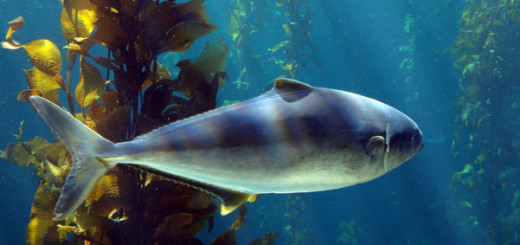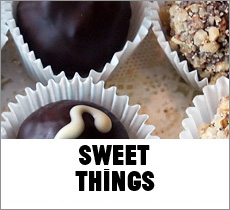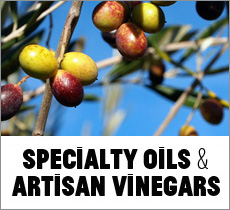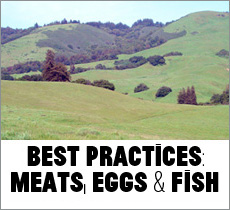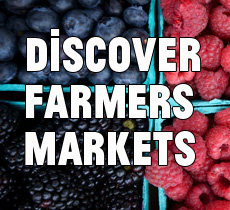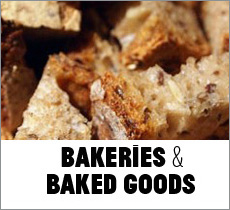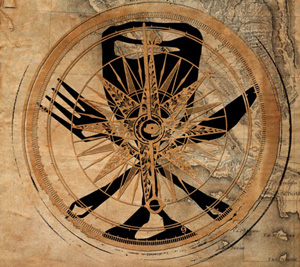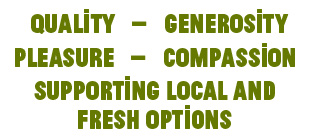Suppertime with Pirates
I didn’t know how to read when I first opened the new Peanuts book I’d received for Christmas 1975. Flipping to the opening strip, I hardly anticipated that I was just about to find the first key to an entire universe of literary characters and worlds that provided me some of the best company and retreats in childhood and beyond. As a writer, I’m pleased the memory remains vivid of the precise moment my brain began to understand written words. As a foodie, I’m delighted to report that the first “big” word I learned integrates food and happiness.
All but one panel of the comic takes place in a downpour. Snoopy gleefully dances in the rain as Charlie Brown stands with a full supper dish and an umbrella. “Suppertime!” sings the exuberant beagle, who quickly scarfs down the food and unceremoniously falls asleep in the empty dish under Charlie Brown’s umbrella. His gluttonous behavior—including “Chomp Chomp mmmm” sounds—helped me decode the string of 10 letters repeated 6 times on the page: “Suppertime?”
I remember experiencing a mental jolt as my brain connected word and food, idea and matter on its own for the first time: “Suppertime!” That simple yet layered comic strip with a joyful Snoopy and a deadpan Charlie Brown—“I wonder what would happen if I traded him in for a couple of goldfish …”—opened the door for me into a new universe of reading. It was an ur moment both for a future English major and a future foodie excited about great food and drink.
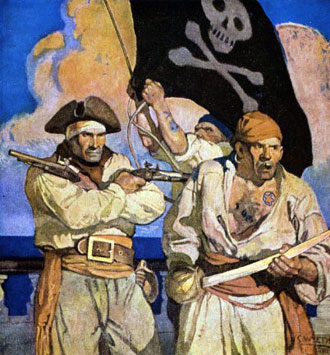
pirates with a Jolly Roger
Treasure Island Terroir
If you’ve ever done a double take with our Jolly Roger-esque logo—thinking for a moment that our glass, fork, and knife looks like a skull and crossbones—you’re onto something. I can’t remember exactly how old I was when I first read Treasure Island by Robert Louis Stevenson but I know this pirate story with rich illustrations from N. C. Wyeth was one of the first big books I read before my teen years and one of my favorites. I was captivated with the story’s energy, movement, and freedom from the first time I devoured its chapters in a marathon reading session.
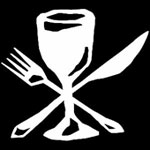 Obviously, growing up in the staid Dayton, Ohio, suburbs was much less interesting than Jim’s journey in this adventure story. Instead of always having to live the boring reality of a suburban Midwestern kid, when I read and reread Treasure Island, I identified with Jim who had a chance to do so many exciting things, from overhearing important and dangerous conversations to stowing away with the unwitting pirates to the island for even more edgy adventures. Fights in the crow’s nest! Spiritual curses! Vast treasure! What a story!
Obviously, growing up in the staid Dayton, Ohio, suburbs was much less interesting than Jim’s journey in this adventure story. Instead of always having to live the boring reality of a suburban Midwestern kid, when I read and reread Treasure Island, I identified with Jim who had a chance to do so many exciting things, from overhearing important and dangerous conversations to stowing away with the unwitting pirates to the island for even more edgy adventures. Fights in the crow’s nest! Spiritual curses! Vast treasure! What a story!
X Marks the Spot at Point Lobos

Jim and Israel Hands
In 2010, I’d already planned to incorporate some kind of map component with our Central Coast Foodie branding when I learned that Stevenson had written Treasure Island while living in Carmel Valley. He was waiting for his wife-to-be to conclude business in San Francisco (in fact, she was divorcing her first husband) before they could marry and set off for a life of world travel and literary success.
In my academic project I’m completing through Indiana University—Bloomington, I’m particularly interested in the intersection of literary and physical spaces. Imagine my pleasure when I discovered that one of my favorite stories had been envisioned in and around the Northern Central Coast.
Near Carmel-by-the-Sea, from a certain perspective, the peninsular Point Lobos looks very much like an island. It was from here that Stevenson gazed upon, imagined and, yes, mapped this stand-in for Skeleton Island, the site of the buried treasure. As he was preparing the manuscript for the publisher, Stevenson submitted an intricate map of the “island” to accompany the story that he’d annotated throughout the writing process.
He writes of the importance of maps to good stories:
The map was the chief part of my plot. […] I have said it was the most of the plot. I might say it was the whole. […] It is perhaps not often that a map figures so largely in a tale; yet it is always important. The author must know his countryside, whether real or imaginary, like his hand….
—Robert Louis Stevenson
He was aghast to learn that the map had gone missing at the publishers and sadly set about creating a new one that never lived up to the rich detail of the original. Given Stevenson’s tale of cunning men plotting to lay hands on the real treasure map, perhaps he should not have been so surprised that a treasure map submitted with an adventure story might mysteriously disappear.
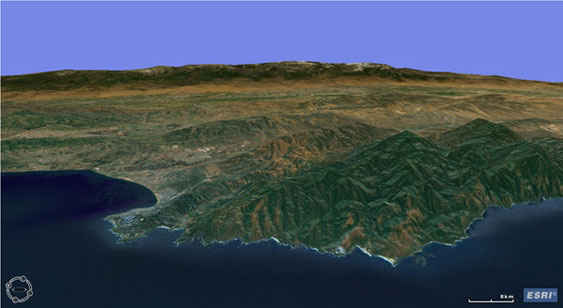
Northern Central Coast: Monterey Bay to Big Sur
He goes on about maps:
But it is my contention—my superstition, if you like—that he who is faithful to his map, and consults it, and draws from it his inspiration, daily and hourly, gains positive support, and not mere negative immunity from accident [by avoiding the inclusion of inaccurate details]. The tale has a root there; it grows in that soil; it has a spine of its own behind the words. Better if the country be real, and he has walked every foot of it and knows every milestone. But, even with imaginary places, he will do well in the beginning to provide a map. As he studies it, relations will appear that he had not thought upon. He will discover obvious though unsuspected shortcuts and footpaths for his messengers; and even when a map is not all the plot, as it was in “Treasure Island,” it will be found to be a mine of suggestion.
—Robert Louis Stevenson
Stay tuned for more foodie map tools for discovering the delicious Central Coast.
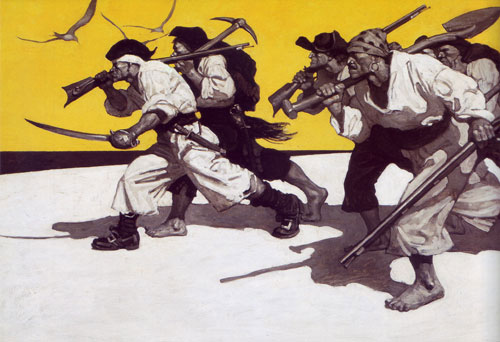
Jim’s perspective on pirates
— comic: Charles M. Schulz
— illustrations: N. C. Wyeth

